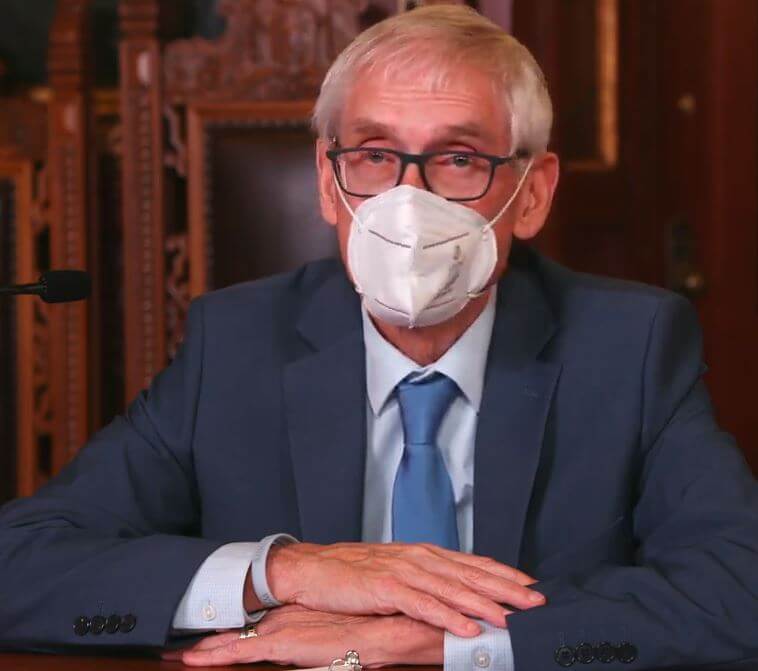How Evers Spent $2 Billion to Fight Covid
A very long list of recipients. But the money runs out on January 1.
The Federal Reserve estimated Wisconsin’s gross domestic product – the value of all goods and services produced in the state – at $346.4 billion in 2019. Compare that number to how much extra emergency federal aid – $2 billion – Democratic Gov. Tony Evers got to try and hold together Wisconsin’s economy and health care systems in the face of the COVID-19 pandemic.
The Evers Administration has reported how it spent that $2 billion, saying it made an important difference.
“We’ve expanded testing, assisted more than 13,000 households pay rent, provided direct aid to more than 15,000 farmers,” Evers told reporters. “We’ve invested in our tourism, lodging and entertainment industries that have been hit really hard.”
But how soon the state and nation beat the COVID-19 cycle of sickness, hospitalizations and deaths, and whether more federal aid is forthcoming, will determine Wisconsin’s quality of life in 2021, he added. That $2 billion in federal cash runs out on Jan. 1 “if we don’t get additional federal resources,” Evers said. “We need urgent action from Congress now.”
Talks in Washington between the outgoing Trump Administration, President-elect Joe Biden and Congressional leaders are stalled, however.
Evers estimated that continuing testing, contact tracing and COVID-19 help for stressed hospitals and other health-care systems would cost an additional $541 million in state funds between January and March of next year.
Because the $2 billion Evers spent is your money, you’re entitled to know how he spent it. According to the state Department of Administration (DOA) summary, the most expensive programs were:
-$478.6 million for COVID-19 tests, including lab costs, supplies, specimen collection and preparedness. National Guard members and local workers conducted 2.5 million tests between March and Thanksgiving Day, with an average positive rate of 15%, although that rate soared over the last month.
-$201 million in Routes to Recovery aid to local and tribal governments.
-$188 million for “We’re All In” grants of up to $5,000 for small businesses and Innovation projects.
-$165 million, including $130 million to buy personal preparedness equipment and $35 million for ventilators for the sickest patients.
-$130 million to pay COVID-19 costs of state agencies.
-$122 million for what officials labeled “surge operating costs,” including $82 million to open the Alternate Care Facility at State Fair Park for those who could be released from hospitals and $40 million for hospital and nursing home staffing.
-$100 million in “provider payments” to long-term care and community-based facilities and EMS responders.
-$80 million in Child Care Counts payments to organizations that provide child care.
-$75 million for state and local contact tracing programs, which have been overwhelmed and unable to keep up with the number of positive cases.
-$60 million to supplement payments to long-term care facilities.
-$50 million in direct payments to farmers.
-$40 million to hospitals.
-$37 million to colleges and universities.
-$35 million to help low- and middle-income families pay their rent.
Awards announced by the Evers Administration show who was helped by two other, less costly programs.
The Cultural Grants program awarded $15 million to statewide groups. Those grants ranged from $555 to Share, Accept, Grow, Encourage Inc. in Green Bay and $975 for the Encore Handbell Ensemble in Oshkosh to a maximum of $137,712, which went to more than 40 organizations.
More than half of those maximum grants of $137,712 went to these 21 Milwaukee-area organizations: Polish Heritage Alliance, Irish Festival Inc., Milwaukee Youth Symphony Orchestra, Florentine Opera, Zoological Society of Milwaukee County, Marcus Performing Arts Center, Milwaukee Art Museum, First Stage Milwaukee, Radio Milwaukee, Urban Ecology Center, Skylight Music Theatre, Danceworks, Milwaukee Public Museum, Milwaukee Repertory Theatre, Milwaukee Film, Discovery World, Pabst Mansion, Betty Brinn Children’s Museum, Milwaukee Ballet, Pabst Theater Foundation and Milwaukee Symphony Orchestra.
And full disclosure: $100,000 of the $2 billion went to WisconsinEye.
Steven Walters is a senior producer with the nonprofit public affairs channel WisconsinEye. Contact him at stevenscotwalters@gmail.com
If you think stories like this are important, become a member of Urban Milwaukee and help support real, independent journalism. Plus you get some cool added benefits.
More about the Coronavirus Pandemic
- Governors Tony Evers, JB Pritzker, Tim Walz, and Gretchen Whitmer Issue a Joint Statement Concerning Reports that Donald Trump Gave Russian Dictator Putin American COVID-19 Supplies - Gov. Tony Evers - Oct 11th, 2024
- MHD Release: Milwaukee Health Department Launches COVID-19 Wastewater Testing Dashboard - City of Milwaukee Health Department - Jan 23rd, 2024
- Milwaukee County Announces New Policies Related to COVID-19 Pandemic - County Executive David Crowley - May 9th, 2023
- DHS Details End of Emergency COVID-19 Response - Wisconsin Department of Health Services - Apr 26th, 2023
- Milwaukee Health Department Announces Upcoming Changes to COVID-19 Services - City of Milwaukee Health Department - Mar 17th, 2023
- Fitzgerald Applauds Passage of COVID-19 Origin Act - U.S. Rep. Scott Fitzgerald - Mar 10th, 2023
- DHS Expands Free COVID-19 Testing Program - Wisconsin Department of Health Services - Feb 10th, 2023
- MKE County: COVID-19 Hospitalizations Rising - Graham Kilmer - Jan 16th, 2023
- Not Enough Getting Bivalent Booster Shots, State Health Officials Warn - Gaby Vinick - Dec 26th, 2022
- Nearly All Wisconsinites Age 6 Months and Older Now Eligible for Updated COVID-19 Vaccine - Wisconsin Department of Health Services - Dec 15th, 2022
Read more about Coronavirus Pandemic here
The State of Politics
-
RNC Brings Fame to Gen Z Party Leader
 Jul 15th, 2024 by Steven Walters
Jul 15th, 2024 by Steven Walters
-
Wisconsin’s Republican Roots Run Deep
 Jul 8th, 2024 by Steven Walters
Jul 8th, 2024 by Steven Walters
-
Feuding Supreme Court Justices Need a Break
 Jul 1st, 2024 by Steven Walters
Jul 1st, 2024 by Steven Walters






















